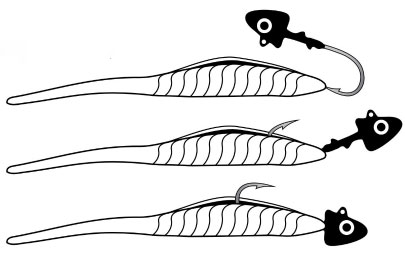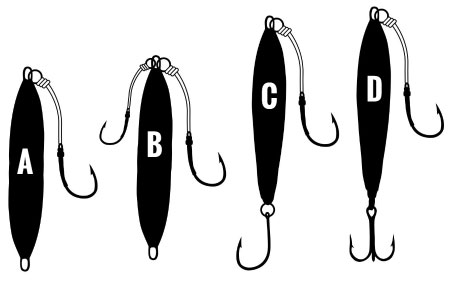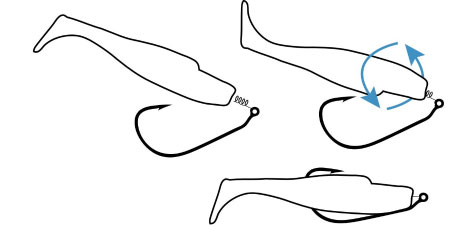If you missed last month's initial installment in this series, be sure to read Rigging for Beginners, Part I: Critical Rigs.

There are few things more frustrating than buying a lure, using it without success, and then discovering that you had rigged it up all wrong. (Just for the record, dragging a lure around all day long only to discover in the eleventh hour that you had failed to remove the plastic hook guard is even worse — been there, done that).
Some lures come with instructions, others don’t, and you can learn a lot on YouTube. Unfortunately, a lot of what you can learn on YouTube is also patently wrong. With these basics under your belt, however, any ambitious beginner angler can get rigged up right and start catching fish.
Rigging Soft Plastic Jigs
We’ll start with this one first since soft plastics are so incredibly popular and effective in our region. And fortunately, rigging these up is easy. Most will have a slot or pocket molded into the plastic, sometimes called the "hook pocket." Simply insert your hook in the front of the lure, push it through until the point comes out of the pocket, and push the plastic all the way up the hook shank to the head.

When the bite is red hot and it isn’t as important to get every little bit of action out of the tail, some anglers will flip the tail over and push the hook out through the lure upside-down, to avoid the hook pocket. The theory is that this makes for a tougher rig that will stand up to more abuse from multiple fish. There are also some soft plastics out there with no hook pocket. In these cases, just try to make sure the hook is on an even keel in the tail so it swims level and upright.
Wait a sec – should lures with paddletails point up, or should they go down? There’s a running debate on this, but we see zero difference in the results so feel free to put that tail on facing whichever way you like.
Rigging Trolling or Wobbling Spoons
The spoons themselves will be ready to use right out of the package, but how you’ll want to rig them up on the line will differ by tactic by species. Rigging a Clark spoon for mackerel trolling is, for example, quite different from rigging a Tony for striped bass. The variations and variables are too numerous to list out here, but fortunately, we’ve covered them before and you can see these rigs and more by checking out Chesapeake Bay Multispecies Trolling.
Beyond looking up the specifics, there are a couple of commonalities in rigging trolling or wobbling spoons we need to point out for whenever you may try employing these rigs. First, any time you have a spoon that swims and spins, you need to have at least one ball-bearing swivel inline. Cheap barrel swivels won’t do the job. Fail to use a ball-bearing swivel and before you know it your line will become one massive mess of twist, and your cherished rod and reel will amount to nothing more than a tangle factory.
Secondly, as a general rule of thumb you can use heavier leader for rigging up spoons that will be trolled than for those that will be cast and retrieved. Most people retrieve a lot slower than they think (a casually paced retrieve is just a couple mph and it’s virtually impossible to crank most reels fast enough to maintain five or six mph for more than a few seconds), so fish will often have plenty of time to eyeball your offering when you’re casting and retrieving.
Rigging Jigging Spoons
Commonly called heavy metal, these spoons are fished in a completely different manner than trolling or wobbling spoons. They can be tied or swivel-clipped right to the end of your leader. Historically most came with a single treble hook on the bottom but these days some fresh in the package are completely unrigged. You’ll need to add hooks, usually in one of the following forms:

All of these different methods have their advantages, and none are “right” or “wrong.” Having no treble or bottom hook works great when you’re in a snaggy area, because it minimizes snags. However, top-only rigs often get slapped and missed if and when fish are striking the spoon as it’s falling. Having a treble on the bottom is best if the fish hit while the jig sinks, but rigged this way you can pretty much count on a snag if it gets anywhere near solid structure. And having both makes for an excellent bait-delivery system when you’re fishing down deep and don’t yet know if fish chunks or squid strips are going to tempt the fish the most.
Rigging Swimbaits
Some swimbaits come pre-rigged, and others will need to be rigged more or less like a soft plastic jig. Most anglers will simply tie these directly to their leader or use a “quick clip” as an attachment point. One variation Mid-Atlantic anglers need to know about, however, is weedless rigging. This style is often used in shallow, weedy waters, when fishing for bass or snakeheads.
Some hooks designed for rigging in this fashion have a gooseneck of sorts near the eye. This allows you to slide the hook through the tip of the bait, slide it onto the gooseneck, then double the point back and push it through the plastic. Some other styles have a tiny barbed stake or a spring you spin into the face of the lure to secure it, before pushing the hook through the plastic. In both cases you’ll want to push the hook through so the point pierces the plastic but lies against it, allowing the lure to pass across weeds without snagging. When a fish chomps down on the lure it compresses the plastic body and you can set the hook.

Rigging Plugs
Most plugs come pre-rigged (and can be tied directly or clipped onto your leader), but most also come with treble hooks. Anglers who care about protecting the fish they release will remove the treble hooks, by opening up the split ring attaching the hook to the eye with a pair of split ring pliers, and replacing them with single hooks. Will you miss a few more bites than you might with trebles? A few maybe, but not by a huge margin. Plenty of fish will still find the swinging singles, and you’ll feel a whole lot better about unhooking and releasing those fish to fight another day. This short video will show how it's done.
Of course, there are plenty of other lures — a million and one varieties, actually — that all require slightly different rigging. But with these basics in your back pocket you can catch everything from rockfish to rock bass, as you continue your quest to catch more, bigger fish.
See Critical Rigging for Beginners, Part III: Rigging Baits.